|
|
|
 |
|
|
|
|
|
|
|
The Old Monastery
|
|

|
|
|
|
|
|
When the Manor of Stortford was owned by the Saxon, Edith the Fair, this prominent position high above the valley was the most likely site of Edith’s Hall: built of timber and thatch like the original Saxon church that stood alongside it, and surrounded by a stockade.
The present three-storey building on this site, currently occupied by Pelly’s Solicitors (founded in Stortford in 1971), was erected in the 17th century as a private residence called Windhill House, but has since undergone a great deal of alteration leaving very little of the original building intact. In the 18th century the timber and plaster walls were encased with bricks, and modernisation of the interior has left only the Jacobean staircase and plaster-work decoration on the dining room ceiling (similar to that found in Cooper's store at Bridge Street). The existing Georgian front was added in 1806 and one hundred years later the rear of the house was greatly extended to form the monastery.
One previous owner in the 18th century was Rev Joseph Clapp. He had also been headmaster of the town’s Grammar school which, after he died in 1767, fell into rapid disrepair and was subsequently pulled down in 1770. With no other premises available for teaching, his widow allowed the house to be used as a temporary school, and it was here that Samuel Johnson's servant, Francis Barber, was taught Latin and Greek until 1772 (See Guide 3 – Francis Barber).
For how long the school remained at the house is unknown but in 1806 the premises was purchased by the Wilby family, local landowners who then rented out the house for the next 90 years or so to the Skeet family. During this time, ownership of the property, and others, was frequently inherited by family members, but with the death in 1903 of W Wilby, the entire estate was put in the hands of his trustees and sold at auction (See St Joseph's Church).
Windhill House and an adjoining property, St Katherines House, were then bought on behalf of the Catholic Church and the proceeds from the entire auction sale (£20,000) inherited by Frederick Wilby. He later bought Piggotts Manor at Thorley out of the proceeds and is recorded as living at Westfield House in 1914.
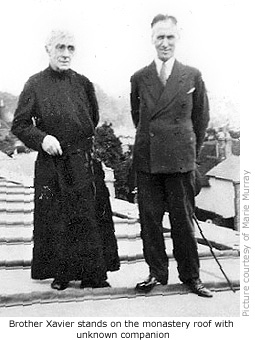 In December 1952 the monastery was almost destroyed when a fire raged here for more than three hours, at one point also threatening the fabric of nearby churches, St Michael’s and St Joseph’s. First on the scene were members of the Salvation Army who, along with locals, formed a human chain to rescue valuable items from inside. But as fifty firemen, using water pumped from the river Stort fought to contain the blaze, one of the monks, Brother Xavier, dashed back into the smouldering building exclaiming ‘I’ve got to save my three nuns’. He then reappeared moments later holding a tin of his favourite pipe tobacco! In December 1952 the monastery was almost destroyed when a fire raged here for more than three hours, at one point also threatening the fabric of nearby churches, St Michael’s and St Joseph’s. First on the scene were members of the Salvation Army who, along with locals, formed a human chain to rescue valuable items from inside. But as fifty firemen, using water pumped from the river Stort fought to contain the blaze, one of the monks, Brother Xavier, dashed back into the smouldering building exclaiming ‘I’ve got to save my three nuns’. He then reappeared moments later holding a tin of his favourite pipe tobacco!
The nuns left the monastery in 1989 and the Redemptorists Fathers withdrew from the church in 1994. They were replaced by a priest appointed by the diocese.
The monastery’s original entrance in Windhill leads to a small quadrangle, now called The Courtyard, and since 1994 part of the building has been home to the Town Council and Tourist Information Centre. The former 5 acre monastery garden, accessed via Pelly's main entrance, is also considerably smaller - a private car park occupying land to the west, and to the south a modern apartment complex named Priory Court, built in the 1990s. The garden's former size can be judged by the original boundary wall that still runs alongside the churchyard pathway linking Windhill with Apton Road.
|
|
|
|
|
|
|
|
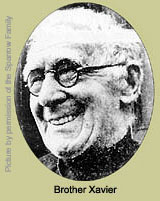 Born in Donegal, Ireland, in 1862, Brother Xavier Kerr was a Glasgow tram driver before he became a Redemptorist Lay Brother. His arrival in Bishop’s Stortford on 5 May 1900, along with Father Oliver Vassall-Phillips, was simply to help find premises in which to start a small monastery and church (See St Joseph's Church), but he ended up staying here for the rest of his life. Born in Donegal, Ireland, in 1862, Brother Xavier Kerr was a Glasgow tram driver before he became a Redemptorist Lay Brother. His arrival in Bishop’s Stortford on 5 May 1900, along with Father Oliver Vassall-Phillips, was simply to help find premises in which to start a small monastery and church (See St Joseph's Church), but he ended up staying here for the rest of his life.
He became a popular and well-loved man in the town, and when he died in 1960, aged 98, was laid to rest in the Monastery garden cemetery – a small, hedged plot of land at the rear of St Joseph’s church. The cross on his grave can still be seen, along with fifteen other crosses marking the graves of former Lay Brothers and priests.
In the 1930s another priest, Father Riley, lived in a small hut in the monastery garden, only going indoors during the very worst winter weather.
|
|
|
|
|
|
St Joseph and the English Martyrs
|
|
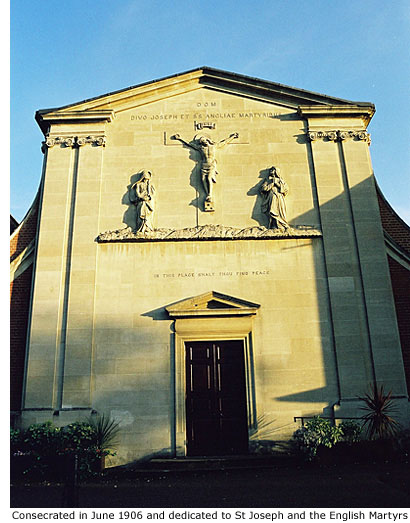 In this history of Bishop's Stortford, all of the town's Christian churches and religious organisations are noted, and a brief introduction is given as to how, why, and when each faith was established. Roman Catholicism, being the foundation of Christianity and the touchstone for all subsequent Christian faiths, needs no such introduction. In this history of Bishop's Stortford, all of the town's Christian churches and religious organisations are noted, and a brief introduction is given as to how, why, and when each faith was established. Roman Catholicism, being the foundation of Christianity and the touchstone for all subsequent Christian faiths, needs no such introduction.
Likewise, nor does the Reformation (having already been adequately covered in the St Michael's Church text), suffice to say that when Elizabeth I came to the throne in 1558, Catholicism ceased to overtly exist in England until the Toleration Act of 1689 allowed everyone the right to worship how they pleased (See Guide 6 – United Reformed Church). Up until that time (apart from a brief period under the Commonwealth and Protectorate 1649–1660, and until the passing of the Act of Uniformity – 1662) Catholics in Bishop's Stortford and elsewhere had been dependent on the ministrations of itinerant priests.
Ironically, due to an oversight in the law, the town became a haven for nonconformists in the mid 17th century and virtually every independent Church was represented here long before local Catholics got their first resident priest in 1896, and their own church in 1900.
This was due, in part, to the arrival in May 1896 of the Sisters of St Mary of Namur, a Roman Catholic order of nuns from the Belgium congregation who were dedicated to providing education for the poor. Of the five Sisters that arrived here it is said only one could speak fluent English, and that little was done by the predominantly protestant townspeople to make them feel welcome. The Bishop's Stortford district is said to have once been the most protestant part of England, this fact probably giving rise to the saying 'Bishop's Stortford's Catholics were nothing but bones.'
The Sisters first set up home in a house at Grange Road (See Guide 12 – London Road) but when the chance came to purchase Windhill Lodge (the present site of St Mary's school in Windhill) they moved in that same year. Naming it St Mary's Convent, they introduced the first Catholic priest to the town since 1558, and established the first school in Stortford to provide children with a Catholic education. At the start the class had just nine pupils.
It is said there were just two Catholic families in Stortford when the Sisters arrived, one German and one Irish, but proof of a growing congregation was a visit to their convent on 16 October 1898 of Cardinal Herbert Vaughan, Archbishop of Westminster. There he administered the Sacraments and Confirmations. Rev J P Shore was chaplain to the Sisters at that time.
Cardinal Vaughan was a missionary at heart who lived to spread the word of God. He must have been suitably impressed with what he found here, because in 1900 he instructed Redemptorist Father Oliver Vassall-Phillips to visit the town and find suitable premises in which to start a small monastery and chapel. He in turn enlisted the help of a Lay Brother named Xavier Kerr, and both arrived in Stortford on 5 May 1900. They lived in a small cottage close to Windhill Lodge and held Mass in the convent every Sunday.
During Father Vassall-Phillips initial search of the town he did find a suitable property in which to start a monastery and chapel, but a passive resistor who hoped to keep Catholics out of the town quickly bought this up. When further searches for property proved fruitless he was of a mind to seek permission from Cardinal Vaughan to move on to the town of Hitchin. But in an encounter with the head of the resident German Catholic family, *John Fehrenbach, his outlook was changed.
Learning of Father Vassall-Phillips plan to leave, Fehrenbach explained that he was a clock and watchmaker from Germany. He had a business in the town, and although his wife Ellen was a Protestant, he was anxious that his four children should be brought up as Catholics. His own Catholic training had taught him to keep the faith under any circumstances, and since the birth of his children he had regularly prayed to St Joseph that a priest might come to town. That prayer had been answered, so why, he asked, was the priest now leaving.
He then took the Father to Newtown to see a disused public house at the corner of Portland Road and Newtown Road that, along with a piece of uncultivated land alongside, might be a suitable site for a small church to be built on. The pub was the former Cricketers Arms that had closed in 1884, and the site proved perfect for the task.
|
|
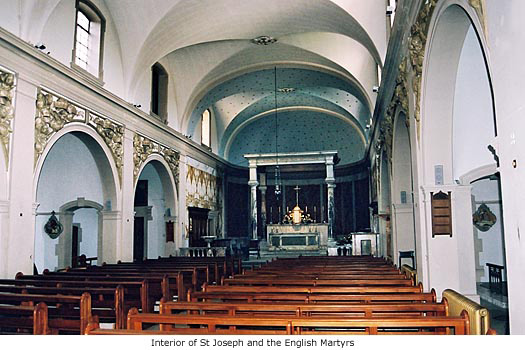 |
|
Within weeks a small 'temporary' church built of corrugated steel was erected, and in November that year (1900) opened for worship. It was named St Joseph's, but its flimsy structure did bring about a certain amount of ridicule from New Town residents who quickly dubbed it the 'Tin Tabernacle'. Regardless of this, local people soon began filling the church every Sunday to sing hymns and listen to simple sermons, and many conversions to Catholicism were made.
Fate then took a hand. In 1903 a large landowner in the town, Mr W Wilby, died. His estate was left in the hands of his trustees, who in November that same year engaged Messrs G E Sworder to sell his properties in an auction held at the George Hotel. One of the properties, Windhill House – comprising of 5 acres, stables and coachman's cottage – went for £3,100, and the adjoining St Katherines House, used as a High School for girls, went for £1,850. Both were bought by a Mr Foster on behalf of the Catholic Church, though this wasn't known at the time. If the purpose of his bidding had been known, then those still determined to keep Catholics out of the town may well have outbid him.
Plans for the site began immediately. The adjoining St Katherines House was to be demolished so that Windhill House could be extended for use as a monastery, and on the site of the old stable block, facing Windhill, would be built the new St Joseph's church.
Renowned church architect, Doran Webb of Salisbury was hired to design the church and apparently visited Florence for his inspiration. He wanted it to blend in with its surroundings, as all small-town Italian churches do, and locals immediately dubbed the resulting Italian style church the ‘Italian Mission’.
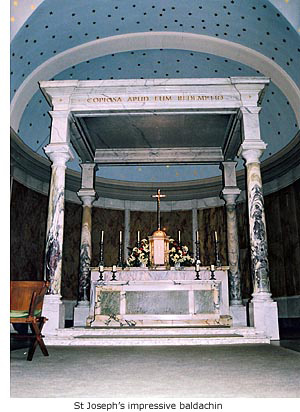 A church in San Miniato designed by Michelangelo inspired the interior, and for this Webb created a star-studded ceiling with scrolls around the arches. He also included a baldachin (a canopy over the pulpit). The marble altar is particularly impressive but the overall decoration was not to everybody’s taste. This was greatly simplified in the 1960s by Father L Hull, who also had the baldachin elegantly altered. A church in San Miniato designed by Michelangelo inspired the interior, and for this Webb created a star-studded ceiling with scrolls around the arches. He also included a baldachin (a canopy over the pulpit). The marble altar is particularly impressive but the overall decoration was not to everybody’s taste. This was greatly simplified in the 1960s by Father L Hull, who also had the baldachin elegantly altered.
The large crucifix on the church's exterior is said to incorporate a representation of Bishop’s Stortford’s four former wayside crosses, and above the entrance porch are carved two Coats of Arms – one of the Redemptorist order, the other of Bishop Edmund Bonner, the last Catholic Bishop of London in Queen Mary’s reign (See Guide 1).
St Joseph's church was a gift of *Father Oliver Vassall-Phillips from his own family resources, who also became the first Rector of the church. A memorial in the entrance records that he died at sea on 8 May 1932.
The church, dedicated to St Joseph and the English Martyrs, was consecrated on 19 June 1906 by Bishop James Fenton. Cardinal Francis Bourne should have carried out the ceremony but he was unable to make it that day. He did, however, attend the following day for the official opening to the general public.
|
|
*The Fehrenbach family were prominent clock and watchmakers in the town from the mid 1800s until the early 1900s (See Guide 13 – The Fehrenbach Family). Without doubt, it was John Fehrenbach's fortuitous conversation with Father Oliver Vassal-Phillips that led to the building of Bishop's Stortford's first Catholic church in Portland Road. This fact is a proud tradition in the family of Marie Murray, she being the great grandaughter of John Fehrenbach. In December 2002, Marie wrote an article about her family in 'Hertfordshire People' – the quarterly journal of the Hertfordshire Family History Society.
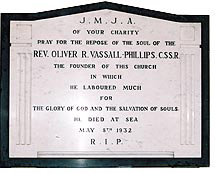 *Father Oliver Vassal-Phillips (1857–1932) died at sea on 8 May 1932, while returning to Bishop's Stortford after a strenuous preaching tour of South Africa. He was aged 75. The eldest son of Robert Lowe Grant Vasall of Bristol, he was educated at Eton, and Baliol College, Oxford. He became a catholic in 1878, then entered the Redemptorist Order and was ordained as a priest in 1884. Before coming to Bishop's Stortford he had been rector in Limerick, Liverpool and Bristol. He was buried at Bishop's Stortford 13 May 1932. *Father Oliver Vassal-Phillips (1857–1932) died at sea on 8 May 1932, while returning to Bishop's Stortford after a strenuous preaching tour of South Africa. He was aged 75. The eldest son of Robert Lowe Grant Vasall of Bristol, he was educated at Eton, and Baliol College, Oxford. He became a catholic in 1878, then entered the Redemptorist Order and was ordained as a priest in 1884. Before coming to Bishop's Stortford he had been rector in Limerick, Liverpool and Bristol. He was buried at Bishop's Stortford 13 May 1932.
*Herbert Alfred Vaughan was born in Gloucester on 15 April 1832, the eldest son of Colonel John Vaughan, a wealthy landowner, and Eliza Vaughan. He was educated at the Jesuit colleges of Stoneyhurst and Brugelette, Belgium, and then at the Benedictine Downside Abbey. Rather than follow in his father's footsteps as a country gentleman, he chose to enter the priesthood. He obviously set a good example to his siblings; five of his seven brothers also became priests, and all five of his sisters became nuns. In 1852 he commenced theological studies in Rome and was ordinated on 28 October 1854 at Lucca in italy, age just 22.
His knowledge of Bishop's Stortford would have come from his time spent at nearby Ware, where his very first post after ordination was that of Vice-Rector at the seminary of St Edmund's, Ware, the main seminary of the South of England. Soon after, he determined to devote himself to missionary work, and though not strong enough himself for the rigours of overseas work, his aim was to achieve this via the establishment of a missionary training college. After fund raising in the Caribbean and South America, he returned to England in 1865 and rented a house in Mill Hill, north London. Thereafter the house became the new missionary training school until a new college was built nearby in 1871.
He was instrumental in establishing missionaries in America and Africa, and in 1892 was ordained Cardinal Archbishop of Westminster. In 1895 he founded Westminster Cathederal, first known as Chapter Hall, which was officially opened on 25 June 1903 – the same day that a Requiem Mass was held for him. MORE PICTURES
|
|
|
|
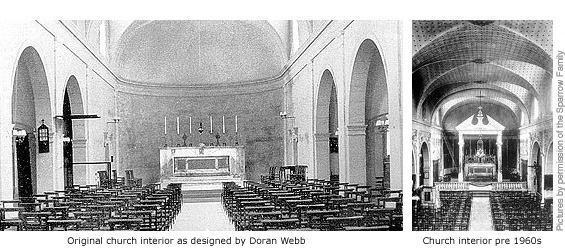 |
|
[ BACK TO TOP ] |
|
|
|
|
|
|
|
|
|






 In December 1952 the monastery was almost destroyed when a fire raged here for more than three hours, at one point also threatening the fabric of nearby churches, St Michael’s and St Joseph’s. First on the scene were members of the Salvation Army who, along with locals, formed a human chain to rescue valuable items from inside. But as fifty firemen, using water pumped from the river Stort fought to contain the blaze, one of the monks, Brother Xavier, dashed back into the smouldering building exclaiming ‘I’ve got to save my three nuns’. He then reappeared moments later holding a tin of his favourite pipe tobacco!
In December 1952 the monastery was almost destroyed when a fire raged here for more than three hours, at one point also threatening the fabric of nearby churches, St Michael’s and St Joseph’s. First on the scene were members of the Salvation Army who, along with locals, formed a human chain to rescue valuable items from inside. But as fifty firemen, using water pumped from the river Stort fought to contain the blaze, one of the monks, Brother Xavier, dashed back into the smouldering building exclaiming ‘I’ve got to save my three nuns’. He then reappeared moments later holding a tin of his favourite pipe tobacco! Born in Donegal, Ireland, in 1862, Brother Xavier Kerr was a Glasgow tram driver before he became a Redemptorist Lay Brother. His arrival in Bishop’s Stortford on 5 May 1900, along with Father Oliver Vassall-Phillips, was simply to help find premises in which to start a small monastery and church (See St Joseph's Church), but he ended up staying here for the rest of his life.
Born in Donegal, Ireland, in 1862, Brother Xavier Kerr was a Glasgow tram driver before he became a Redemptorist Lay Brother. His arrival in Bishop’s Stortford on 5 May 1900, along with Father Oliver Vassall-Phillips, was simply to help find premises in which to start a small monastery and church (See St Joseph's Church), but he ended up staying here for the rest of his life. In this history of Bishop's Stortford, all of the town's Christian churches and religious organisations are noted, and a brief introduction is given as to how, why, and when each faith was established. Roman Catholicism, being the foundation of Christianity and the touchstone for all subsequent Christian faiths, needs no such introduction.
In this history of Bishop's Stortford, all of the town's Christian churches and religious organisations are noted, and a brief introduction is given as to how, why, and when each faith was established. Roman Catholicism, being the foundation of Christianity and the touchstone for all subsequent Christian faiths, needs no such introduction. A church in San Miniato designed by Michelangelo inspired the interior, and for this Webb created a star-studded ceiling with scrolls around the arches. He also included a baldachin (a canopy over the pulpit). The marble altar is particularly impressive but the overall decoration was not to everybody’s taste. This was greatly simplified in the 1960s by Father L Hull, who also had the baldachin elegantly altered.
A church in San Miniato designed by Michelangelo inspired the interior, and for this Webb created a star-studded ceiling with scrolls around the arches. He also included a baldachin (a canopy over the pulpit). The marble altar is particularly impressive but the overall decoration was not to everybody’s taste. This was greatly simplified in the 1960s by Father L Hull, who also had the baldachin elegantly altered. *Father Oliver Vassal-Phillips (1857–1932) died at sea on 8 May 1932, while returning to Bishop's Stortford after a strenuous preaching tour of South Africa. He was aged 75. The eldest son of Robert Lowe Grant Vasall of Bristol, he was educated at Eton, and Baliol College, Oxford. He became a catholic in 1878, then entered the Redemptorist Order and was ordained as a priest in 1884. Before coming to Bishop's Stortford he had been rector in Limerick, Liverpool and Bristol. He was buried at Bishop's Stortford 13 May 1932.
*Father Oliver Vassal-Phillips (1857–1932) died at sea on 8 May 1932, while returning to Bishop's Stortford after a strenuous preaching tour of South Africa. He was aged 75. The eldest son of Robert Lowe Grant Vasall of Bristol, he was educated at Eton, and Baliol College, Oxford. He became a catholic in 1878, then entered the Redemptorist Order and was ordained as a priest in 1884. Before coming to Bishop's Stortford he had been rector in Limerick, Liverpool and Bristol. He was buried at Bishop's Stortford 13 May 1932.